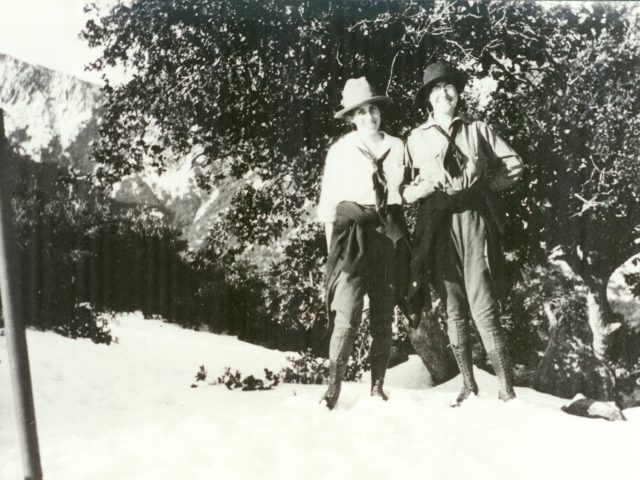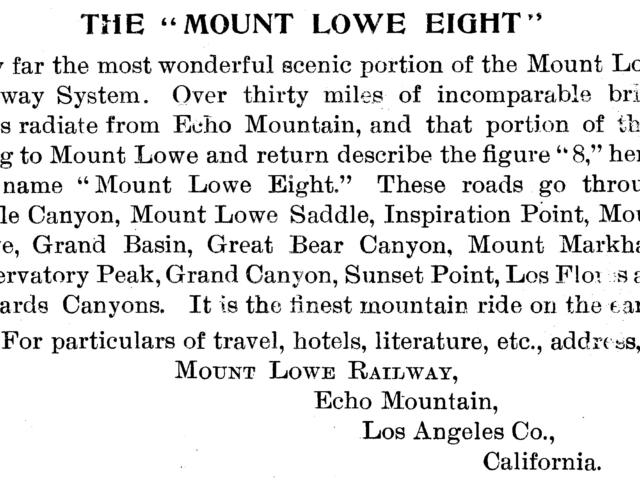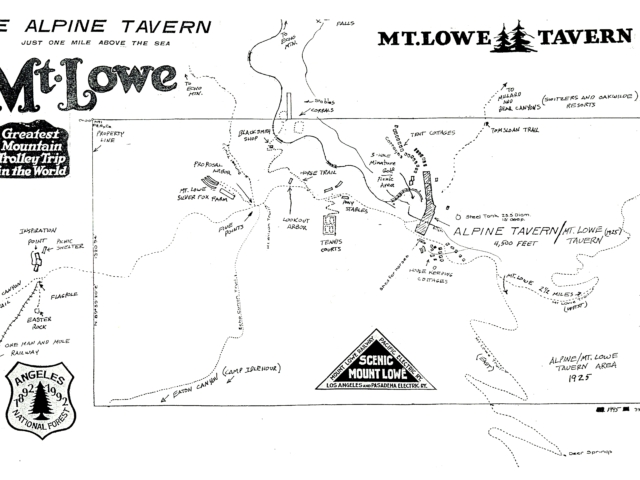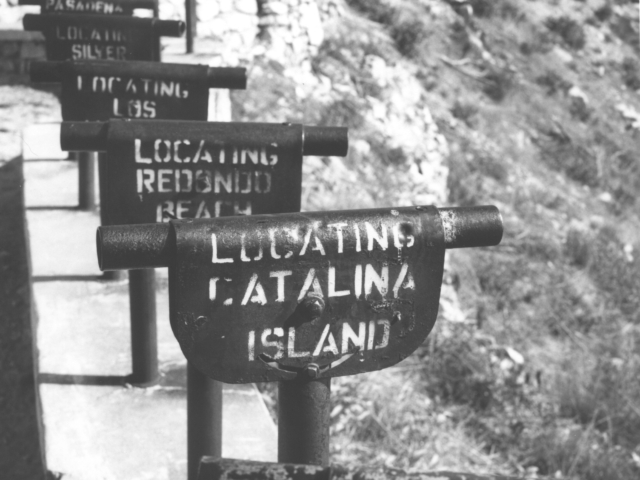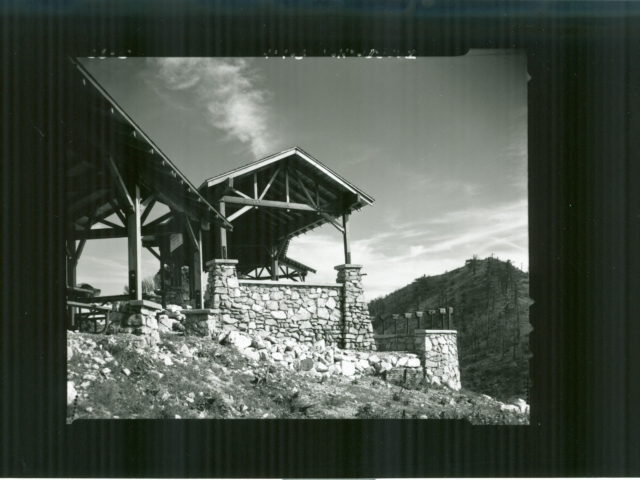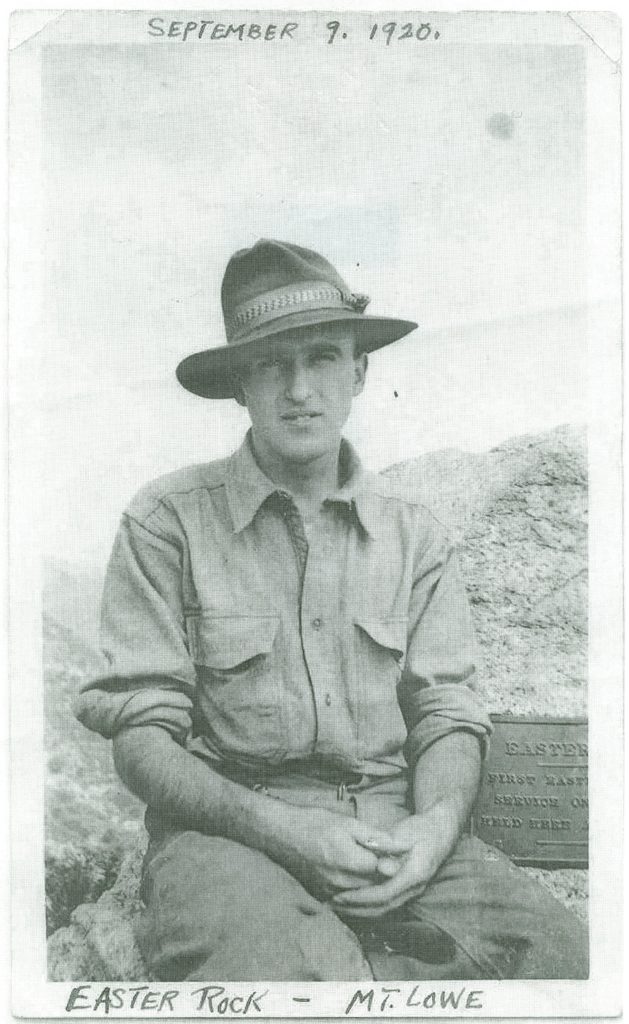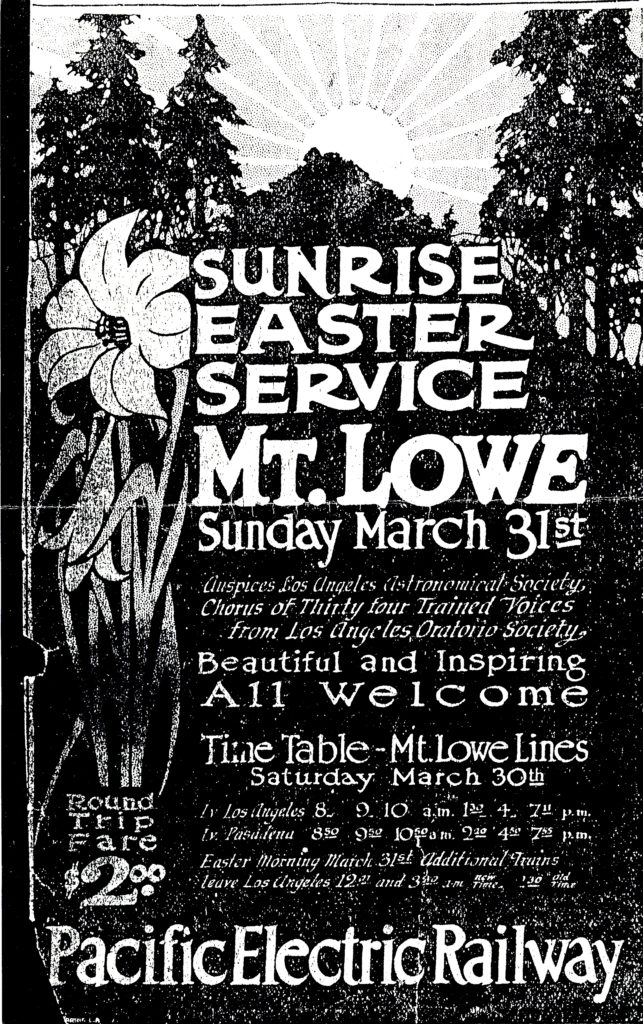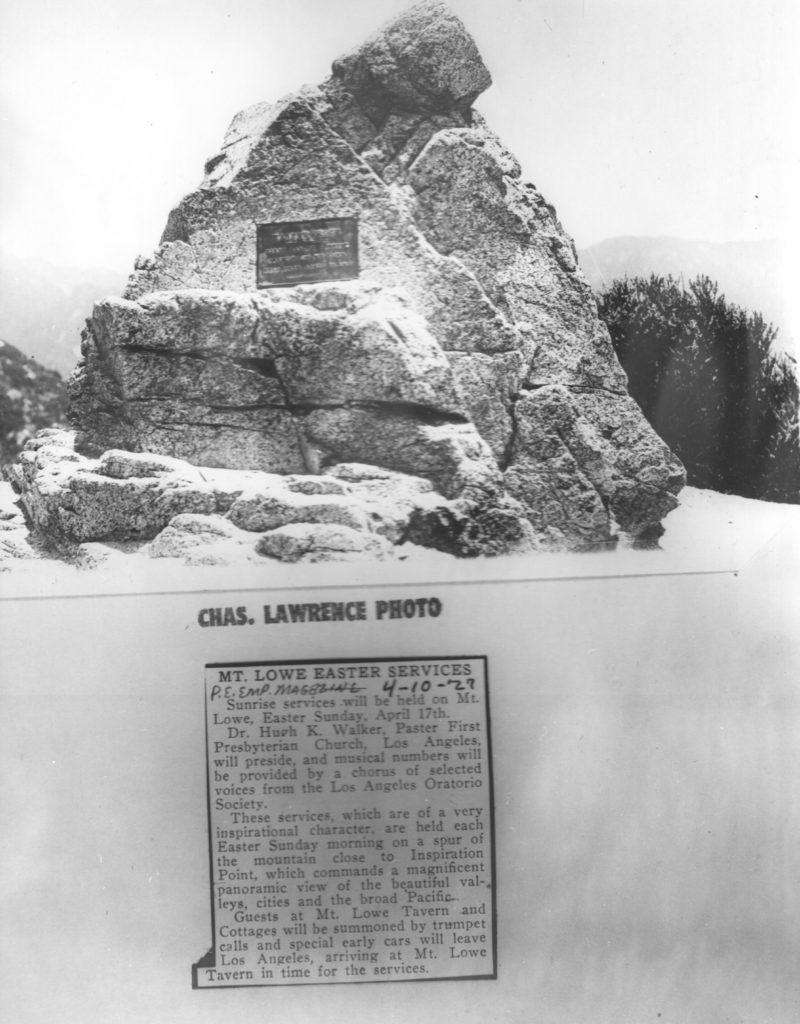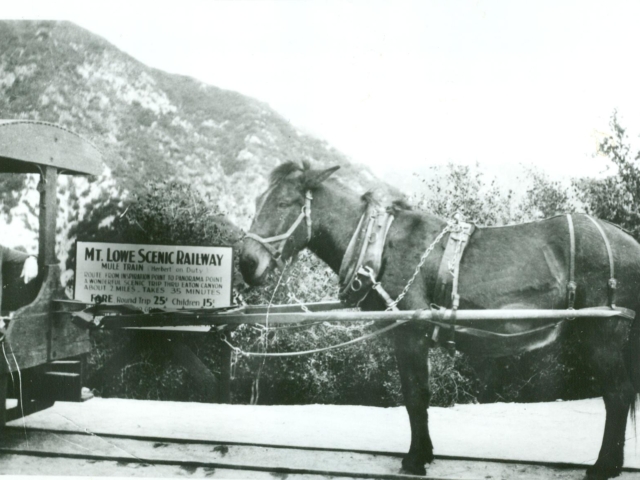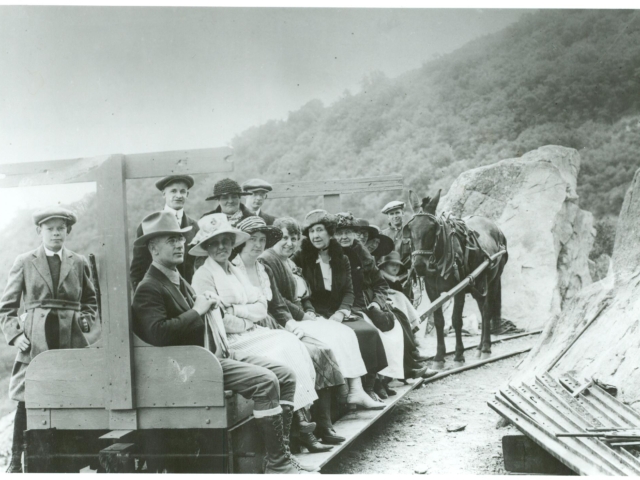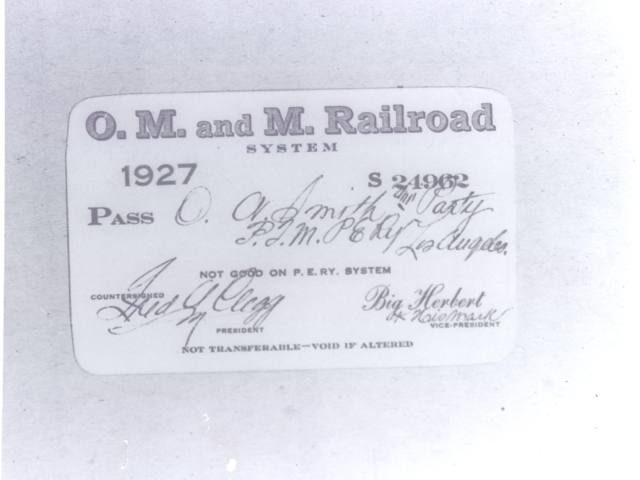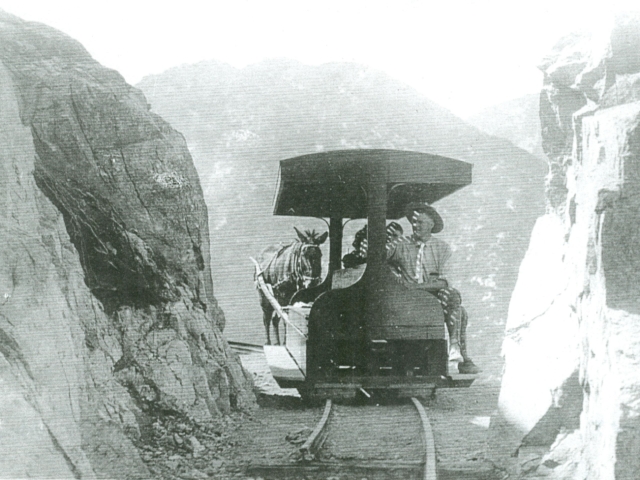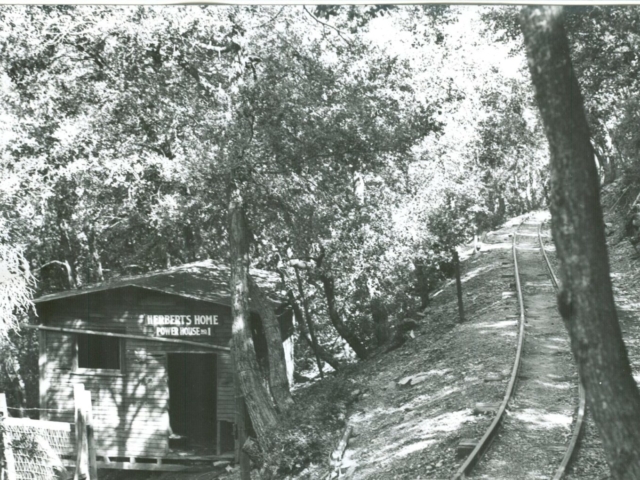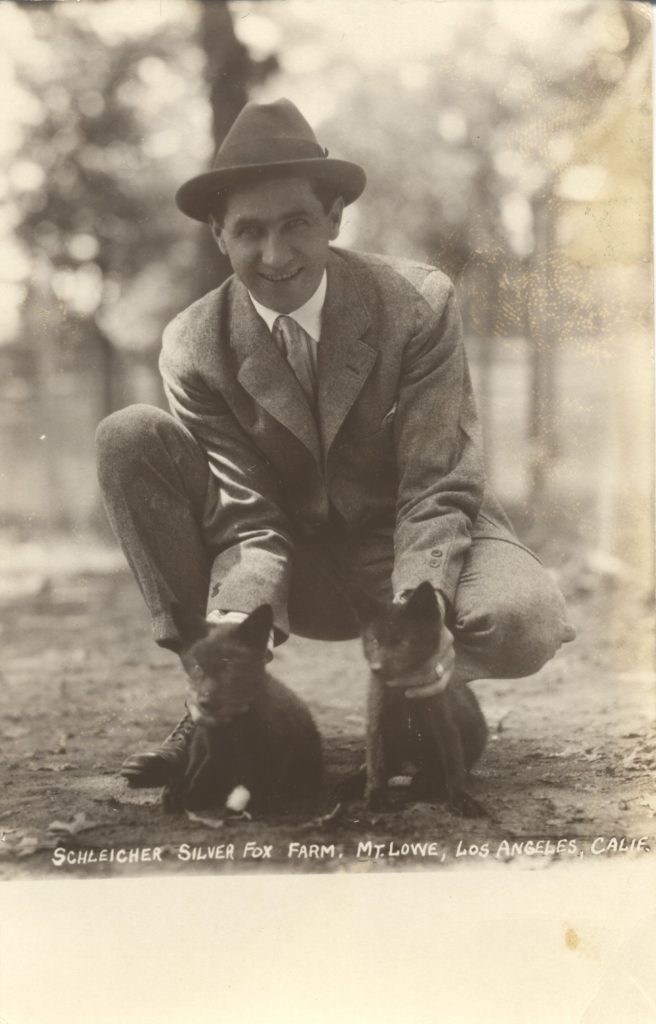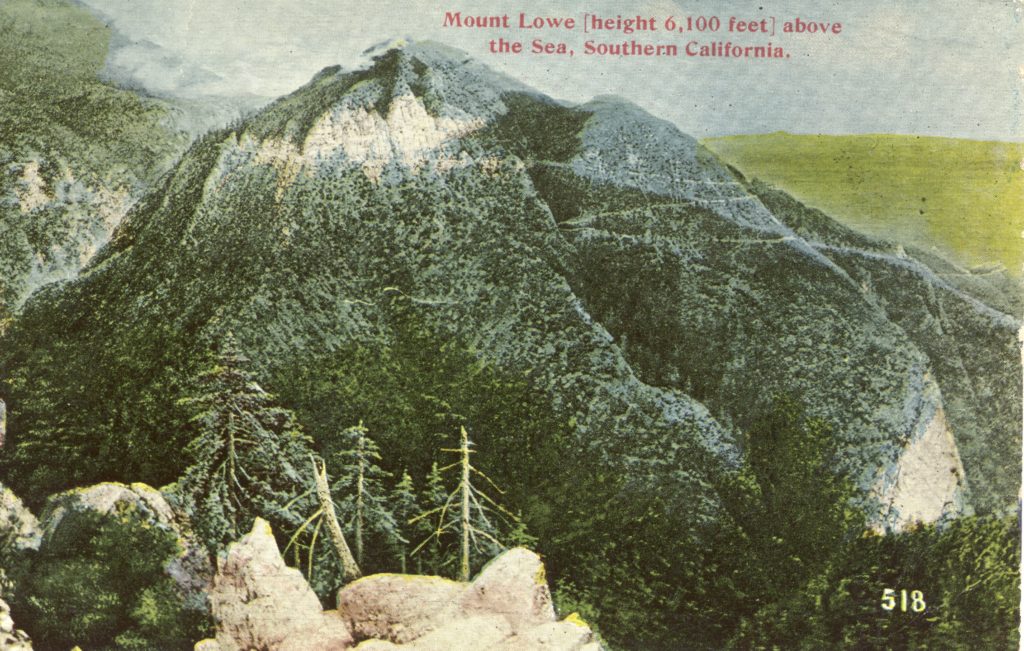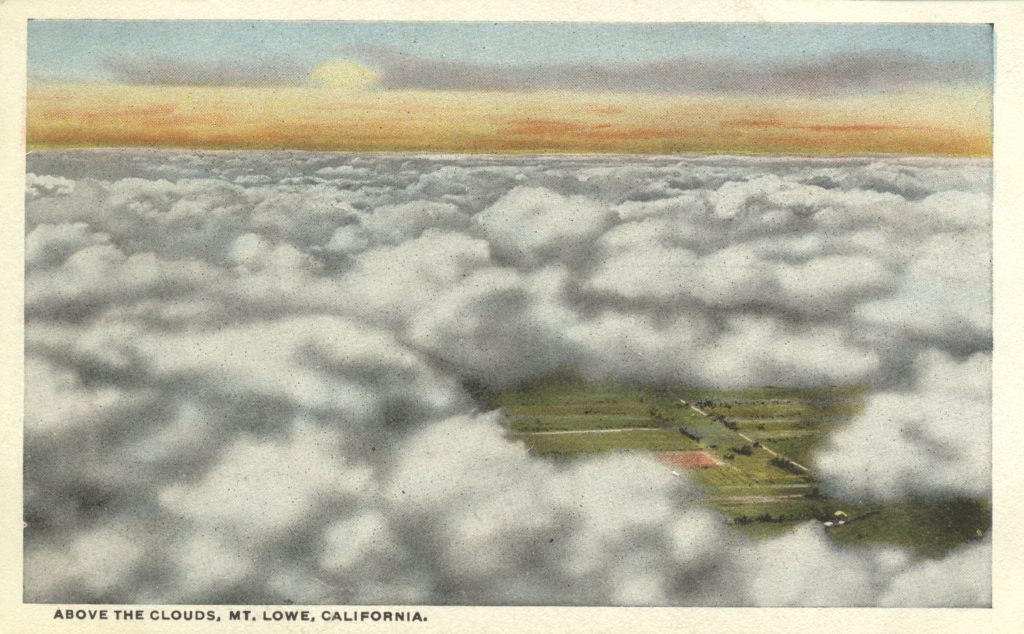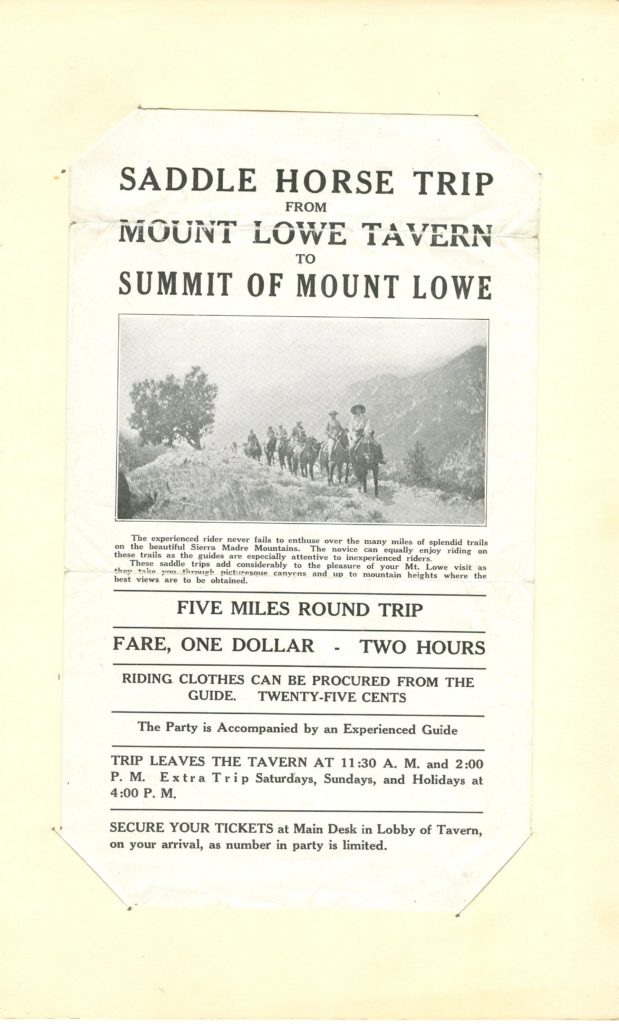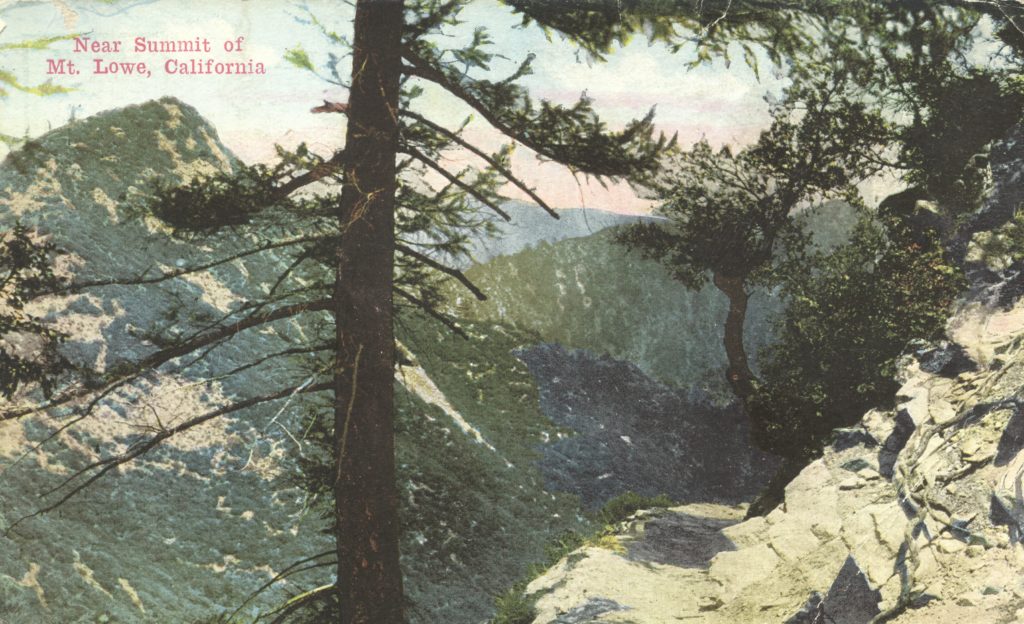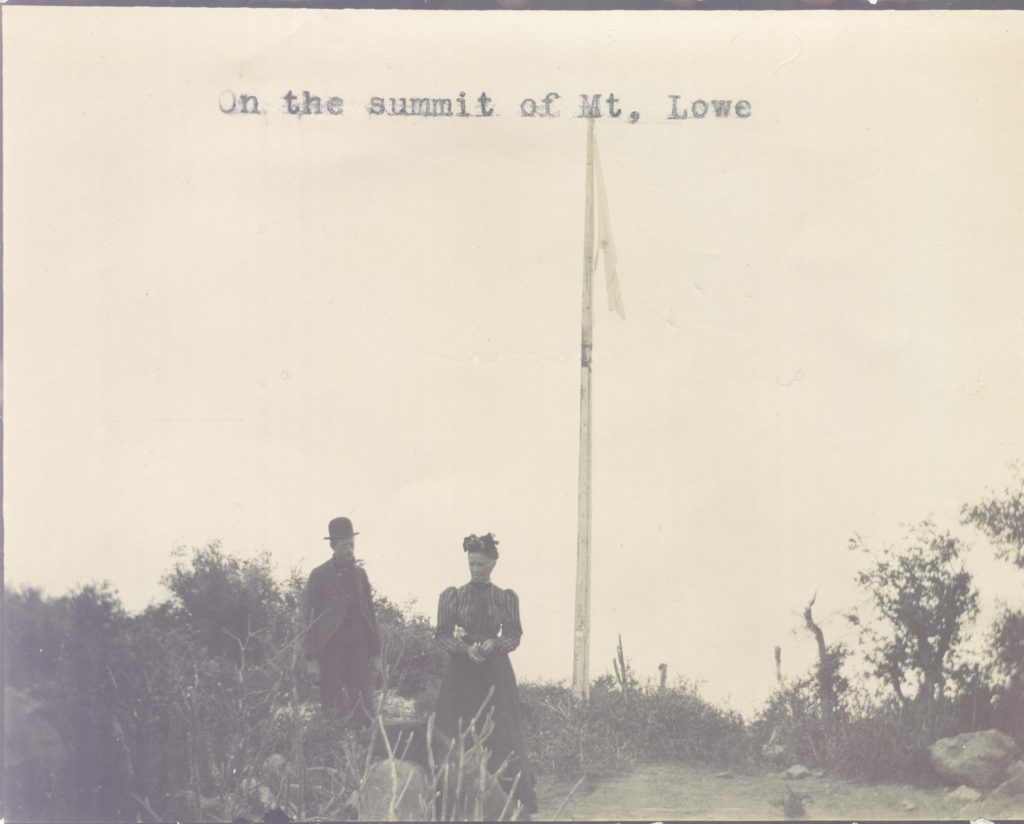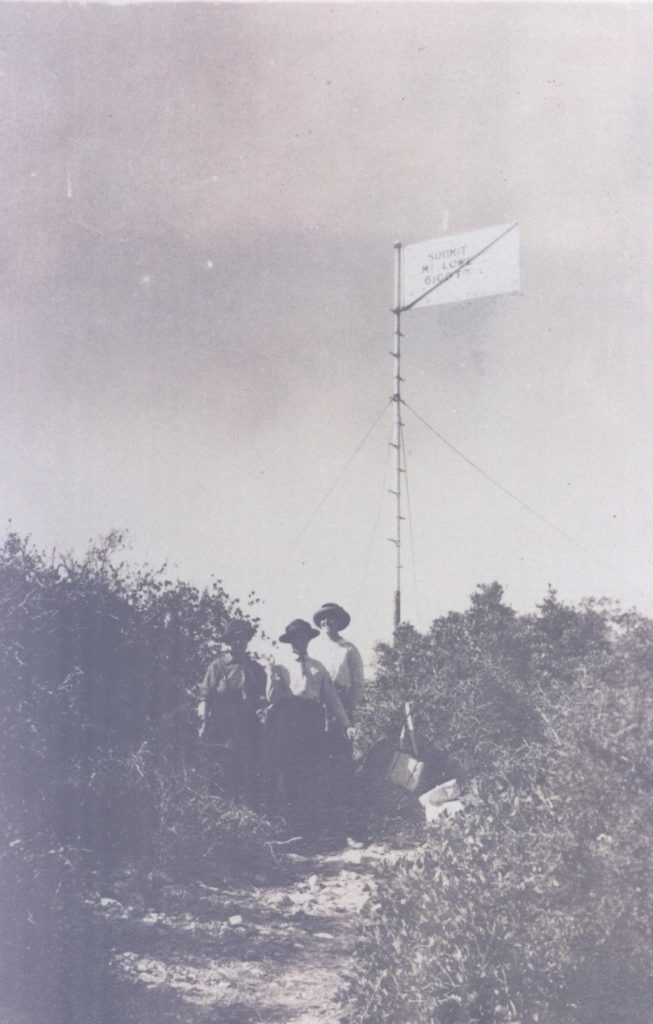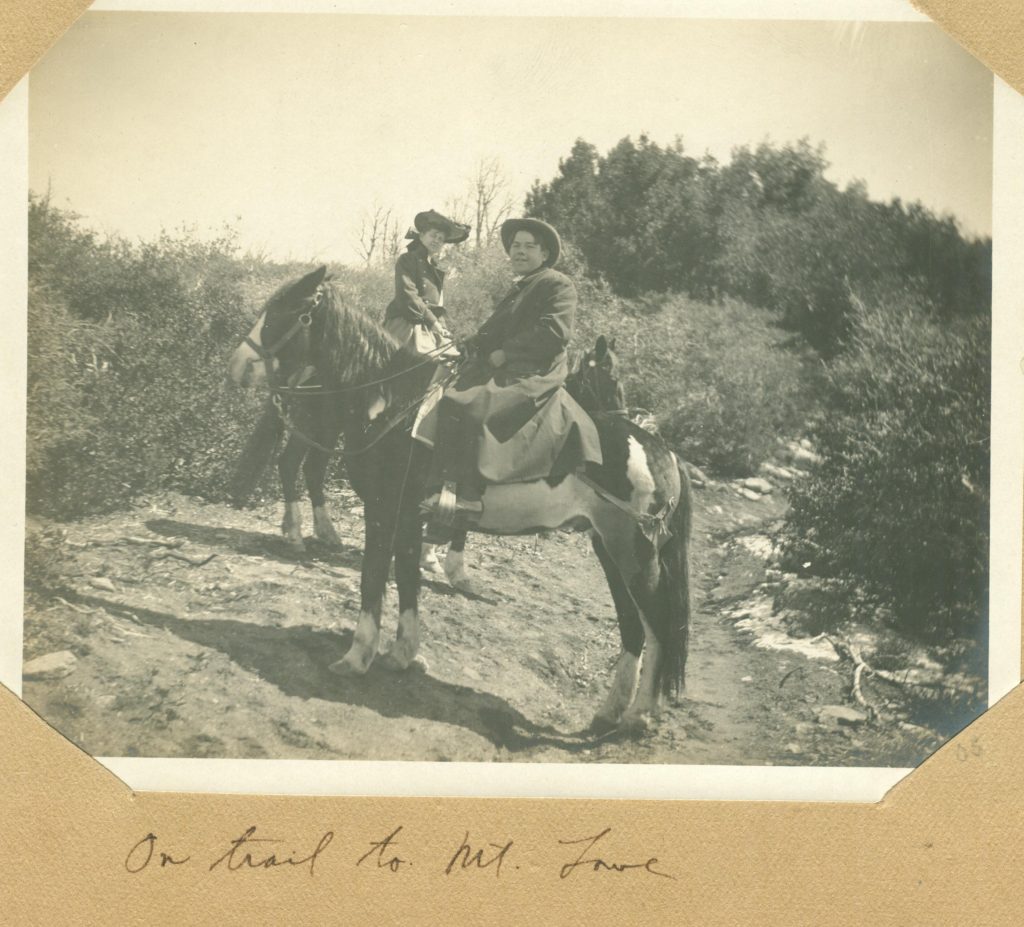Alpine Tavern visitors who wanted more vigorous adventures had their choice of several side trips, all easily reached from the tavern on foot, by horseback, or on burros.
Hikes
This was the Great Hiking Era, and nowhere was hiking more popular than on Mount Lowe. One of the most popular trails accessible from Alpine Tavern was the Mount Lowe Eight, a figure-8 shaped trail, which began near the Mt. Lowe Tavern, looped up to the peak of Mt. Lowe, then down to Echo Mountain, and back to the tavern, never repeating the same path twice. Echo Mountain is 3 1/2 miles from, and 1,200 feet below Alpine Tavern, reachable from Castle Canyon trail. This trail and Sunset Point trail are the lower portion of the Mt. Lowe Eight. Visitors could take either of these trails to Echo Mountain and return by rail, via the Alpine Division.
An easy 10 to 15 minute hike from Alpine Tavern, Inspiration Point was a popular destination for its views of Catalina Island, the San Gabriel Valley and the Los Angeles Basin. As the Mt. Lowe Daily News stated, “Anyone who can walk at all, can take it with ease.” Sunset Point, where thousands of early 20th century tourists enjoyed the southern California sunset, was just one mile away from the Tavern, along the Sunset Point Trail. A pleasant walk through the trees, this was a popular spot in the evening. And Lookout Arbor was an easy eighth of a mile from the Tavern – a perfect spot for small groups to picnic.
Inspiration Point and Environs
Inspiration Point was a destination point as early 1894, when the location marked the end of Castle Canyon Trail. Located a quarter mile from Alpine Tavern, the site offered an unparalleled view of the valleys below. It was not, however, until around World War I, that Pacific Electric publicists gave the overlook its name. At that time benches, viewing tubes and a flagpole were installed. In 1924, Pacific Electric made a number of substantial improvements and additions to the Alpine Tavern facilities, including erecting a pavilion or “ramada” at Inspiration Point.
The Ramada (rebuilt in the 1990s) is still there along with the replicas of the original steel peephole viewing tubes that tourists used to find valley landmarks, 56 cities and the island of Catalina. In a Pasadena-Star News article, 82-year-old Homer “Silky” Griffith recalled his boyhood visit to the area. He rode the Mt. Lowe Railway 15 miles up to the Alpine Tavern and gazed out over the orange groves and poppy fields of the San Gabriel Valley from the Ramada observation deck at Inspiration Point. That was in 1925. “It was so clear and primitive in these parts back then,” Griffith said. “I came up just once when I was 11, but I remember it well.”
Easter Rock
Easter Rock, so named because of the Easter Sunrise Services held there, was a short walk from the Ramada. Thanks to an article in the Mount Lowe Echo, by Mt. Lowe historian Michael Patris, we know what one service, held on April 4, 1926, was like. Railroad cars left Los Angeles at 2:30 a.m., stopping to pick up Pasadena passengers on the way to Mt. Lowe Tavern. Trumpet calls signaled a processional march to Inspiration Point and Easter Rock where a chorus from the Los Angeles Oratorio Society sang Bach’s “All Darkness Flies Before Thy Face.” After the invocation and another hymn, a short sermon and poem followed. The service ended with a closing hymn and benediction. Then, Patris tells us, because everyone dressed up all the time in those days, “after church, everybody could go hiking in his or her Sunday finest.”
One Man and a Mule Railroad
Perhaps Inspiration Point’s most popular attraction, other than the views, was the One Man and A Mule Railroad (OM&M). This unique activity was the brainchild of Ed Tobin who moved west in search of a healthy climate that could cure his tuberculosis. He conceived the idea of a light rail line to provide himself with a small income. Ed Zetterwall, who operated the little railroad, also came to the San Gabriel Mountains to recover from tuberculosis. He laid three miles of light rail track along the ridge east of Inspiration Point to Panorama Point. The line was soon in limited operation and a mule was put into service to operate the car. Visitors boarded the OM&M Railroad at Inspiration Point’s Ramada. Adults were charged 35 cents and children 20 cents.
Common belief was that “Herbert the Mule” pushed the car out along the track to prevent dust from being kicked up on the passengers. Joe Tobin, Ed’s son, however, has reported that Herbert ate much of the “slop” (leftovers) from Alpine Tavern and had horrendous flatulence, That was the reason Herbert pushed his customers instead of pulling them! When Herbert balked or strayed, a cut-down Model-T Ford was used to push the car.
The OM&M operated for about 20 years, from roughly 1915 until 1935, ending just before the demise of the tavern and the Mt. Lowe Railway. After it ceased operation, the rails fell into disrepair. The steel rails were salvaged for scrap during WWII and the timbers removed. The Forest Service now maintains the rail bed as a fire road and trail.
Silver Fox Farm
The Silver Fox Farm was owned and operated by Arthur Schleicher from 1920 to 1936. Located about halfway between Inspiration Point and Alpine Tavern, the Schleicher Silver Fox Farm was the largest in the United States, kenneling over 1,500 animals. Schleicher, from Minnesota, was regarded as the foremost breeder of silver foxes in the United States in the 1920’s. A silver fox pelt cost about $250 to $500. A visitor could order a coat from the farm, where the hides would be tanned, cured and fashioned into a garment of the visitor’s choice.
A visit to the farm, with its tiered cages, was a popular attraction. In addition to foxes, visitors could pet a tamed lynx and see four albino raccoons, the result of a 16 year breeding program conducted by Schleicher. The fox farm was moved to Torrance, California in 1936.
Mount Lowe Summit
Although the trip to the summit was a popular, though strenuous 2 ½ mile climb for hikers, the journey could also be made by horse or burro with an experienced guide. Jason Brown (son of “The Great Liberator” John Brown) was one of those guides. At every point along the path, these trails offered riders some of the best views of cities in the valleys below and surrounding mountains and canyons. Here one saw spectacular sunsets, sunrises and the famous “sea of clouds.” Today views from above the clouds are commonplace for air travelers, but during the time of Mount Lowe Railway, the sea of clouds was truly a phenomenon.
